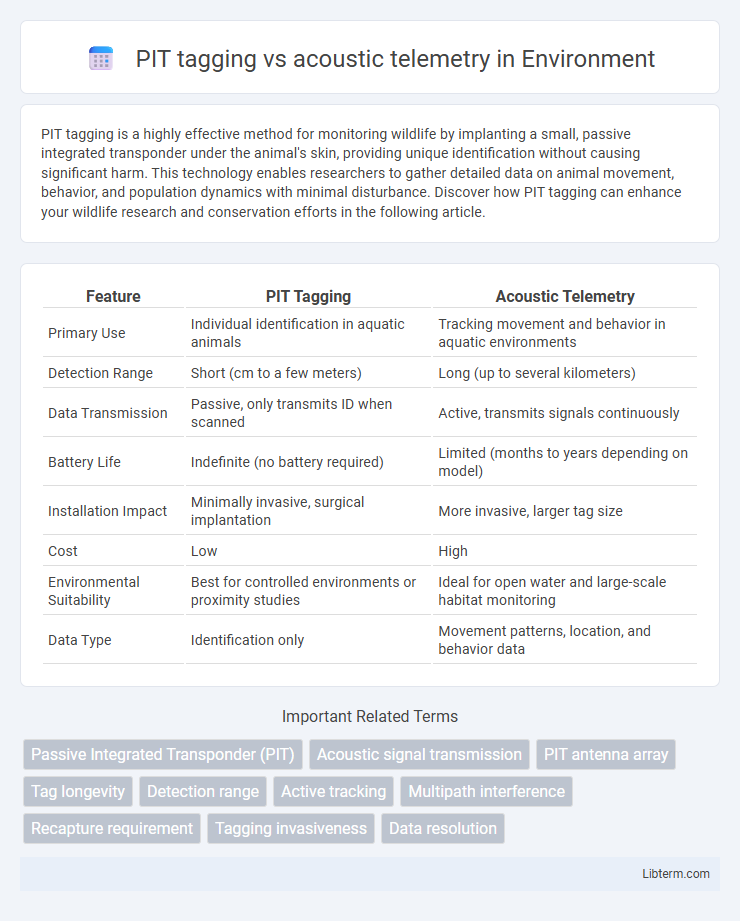PIT tagging is a highly effective method for monitoring wildlife by implanting a small, passive integrated transponder under the animal's skin, providing unique identification without causing significant harm. This technology enables researchers to gather detailed data on animal movement, behavior, and population dynamics with minimal disturbance. Discover how PIT tagging can enhance your wildlife research and conservation efforts in the following article.
Table of Comparison
| Feature | PIT Tagging | Acoustic Telemetry |
|---|---|---|
| Primary Use | Individual identification in aquatic animals | Tracking movement and behavior in aquatic environments |
| Detection Range | Short (cm to a few meters) | Long (up to several kilometers) |
| Data Transmission | Passive, only transmits ID when scanned | Active, transmits signals continuously |
| Battery Life | Indefinite (no battery required) | Limited (months to years depending on model) |
| Installation Impact | Minimally invasive, surgical implantation | More invasive, larger tag size |
| Cost | Low | High |
| Environmental Suitability | Best for controlled environments or proximity studies | Ideal for open water and large-scale habitat monitoring |
| Data Type | Identification only | Movement patterns, location, and behavior data |
Introduction to Fish Tagging Technologies
Fish tagging technologies enhance aquatic research by providing vital data on movement, behavior, and population dynamics. PIT tagging utilizes Passive Integrated Transponder tags that emit unique identification codes when scanned, offering long-term, individual fish tracking with minimal environmental impact. Acoustic telemetry employs sound signal transmitters and underwater receivers to monitor spatial and temporal fish movements over larger aquatic areas, enabling detailed habitat use analysis.
Overview of PIT Tagging
PIT tagging involves implanting a passive integrated transponder under the skin of aquatic animals, enabling individual identification through radio frequency signals when animals pass near a reader. This method offers long-term data collection with minimal impact on behavior and is highly effective for monitoring fish movement and survival in rivers and streams. Although limited by detection range, PIT tags provide reliable, cost-effective tracking in freshwater environments.
Overview of Acoustic Telemetry
Acoustic telemetry uses sound waves to track aquatic animals by attaching transmitters that emit unique acoustic signals detected by underwater receivers. This method enables real-time, long-distance monitoring of movement patterns, habitat use, and behavior in complex aquatic environments. Compared to PIT tagging, acoustic telemetry provides broader spatial data, making it ideal for studying migratory routes and habitat connectivity in fish populations.
Key Differences Between PIT Tagging and Acoustic Telemetry
PIT tagging utilizes passive integrated transponder tags that emit a unique identification signal when scanned, requiring close proximity for detection, whereas acoustic telemetry involves active transmitters emitting sound pulses detected remotely by underwater receivers over larger distances. Key differences include detection range, with acoustic telemetry enabling long-range monitoring up to several hundred meters compared to PIT tags' limited detection radius of a few centimeters to meters. Furthermore, acoustic telemetry allows real-time movement tracking in diverse aquatic environments, while PIT tags provide data mainly at specific reading stations.
Detection Range and Data Collection
PIT tagging offers a limited detection range, typically requiring close proximity to antennas for data collection, making it ideal for monitoring specific locations such as fish ladders or hatcheries. Acoustic telemetry provides a significantly greater detection range, often spanning hundreds of meters to several kilometers, enabling remote and continuous tracking of aquatic animal movements in larger habitats. Data collected via acoustic telemetry includes real-time positional information, while PIT tagging yields presence or absence data only when tagged individuals pass near a reader.
Tagging Procedure and Animal Welfare
PIT tagging involves implanting a small microchip under the animal's skin using a sterile hypodermic needle, causing minimal stress and rapid recovery with low risk of infection or behavioral disruption. Acoustic telemetry requires surgically implanting or externally attaching a transmitter, which can result in longer handling times and potentially more invasive procedures, potentially increasing stress and affecting animal behavior. Both methods demand trained personnel and adherence to ethical guidelines to minimize impact on animal welfare during tagging.
Applications in Fisheries Research
PIT tagging provides precise individual identification for monitoring fish growth, survival, and migration patterns in freshwater environments, making it ideal for population dynamics studies. Acoustic telemetry enables tracking of fish movement and behavior over larger spatial scales and longer durations, particularly useful in marine and estuarine ecosystems. Combining both methods enhances data accuracy on habitat use, fish passage efficiency, and responses to environmental changes in fisheries research.
Cost Comparison and Resource Requirements
PIT tagging offers a low-cost solution with minimal equipment expenses, primarily requiring passive integrated transponder tags and handheld readers, making it suitable for large-scale studies with limited budgets. Acoustic telemetry involves higher upfront costs due to the purchase of active acoustic transmitters, receivers, and ongoing maintenance of an array, demanding significant financial and technical resources. Acoustic telemetry requires extensive field deployment and data management infrastructure, while PIT tagging needs less intensive monitoring but is limited by detection range.
Limitations and Challenges of Each Method
PIT tagging is limited by its short detection range, typically requiring close proximity or a stationary reader, which restricts data collection to controlled environments or specific passage points. Acoustic telemetry faces challenges such as signal attenuation in complex habitats, limited battery life of transmitters, and the high cost of equipment and maintenance. Both methods can be affected by environmental factors like water conductivity and terrain, influencing data accuracy and monitoring effectiveness.
Selecting the Right Tagging Method for Research Goals
Selecting the right tagging method depends on research goals such as monitoring range, behavior, and environmental conditions. PIT tags offer long-term, cost-effective identification ideal for small-scale, stationary studies with limited detection range. Acoustic telemetry suits broader spatial tracking and real-time movement analysis in aquatic environments, providing richer data for migration and habitat use research.
PIT tagging Infographic

 libterm.com
libterm.com